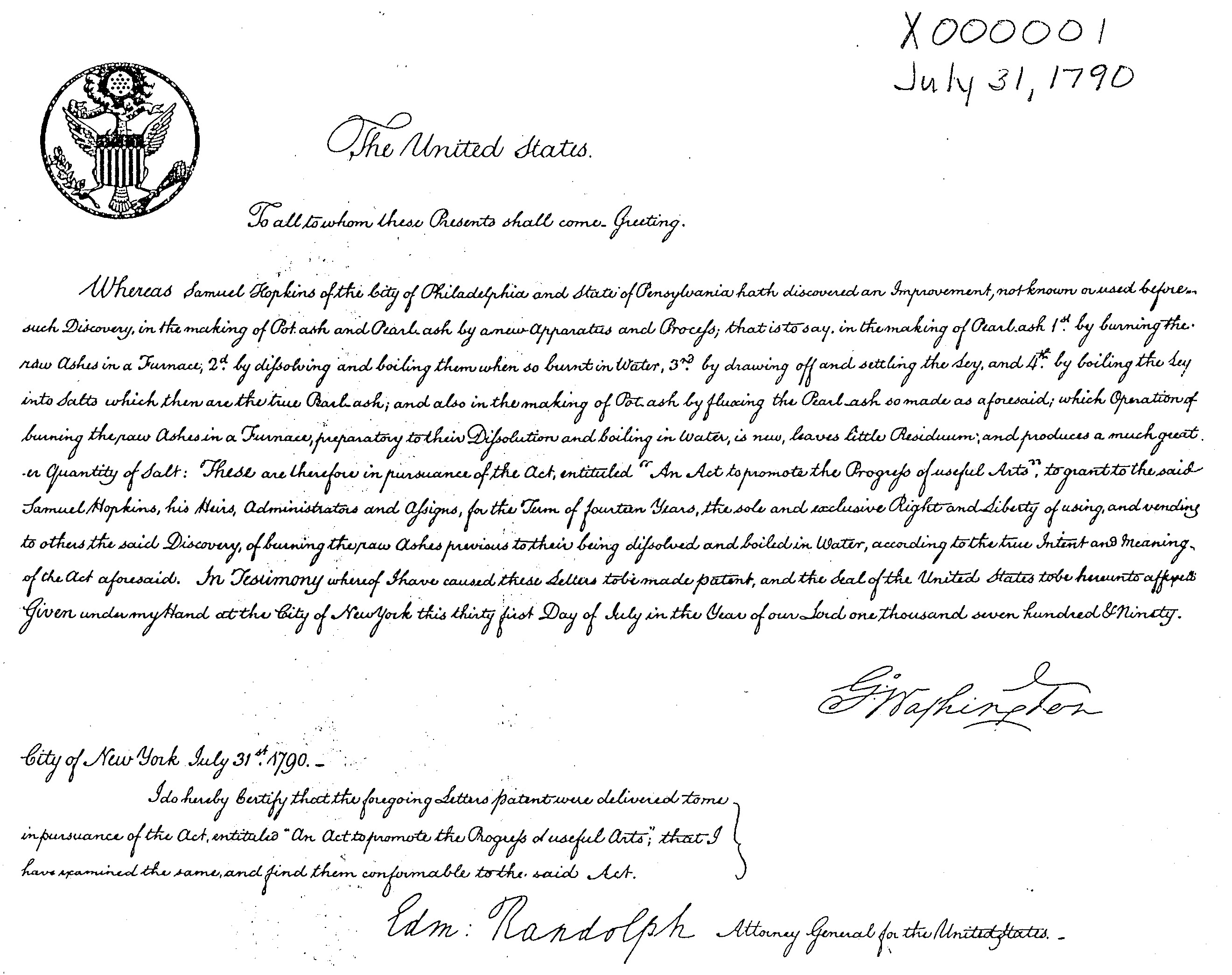 |
| Samuel Hopkin's patent with the original signatures. The date and number in the top right of the page were addeda after the Patent Act of 1836. |
On
July 31, 1790 President George
Washington affixed his signature to
a document granting the First United States Patent. It was the culmination of a process that began when Secretary of State Thomas Jefferson, himself an inventor with more than a passing interest in innovation carefully reviewed the
application. When he concluded that the submission was both original and useful he signed the document and passed it on to Secretary of War Henry Knox who also
approved it and then sent it to Attorney
General Edmund Randolph. Only when
he was finished with it did it land on Washington’s desk.
It
was a cumbersome procedure entailing
most of the Executive Branch of the
still new Federal Government. It was an improvisation by Jefferson who for some reason left out his rival for Washington’s favor, Secretary of the Treasury Alexander
Hamilton despite the New Yorker’s
avowed interest in encouraging
American industry. Chances are very good that the snub was not accidental.
Jefferson
had to ad lib a review process
because when Congress authorized the
government to issue patents it neglected to say how it should be done. The act simply authorized the government to carry out the powers described in Article 1. Section 8 of the Constitution:
Congress
shall have the power...to promote the progress of science and useful arts by
securing for limited times to authors and inventors the exclusive right to
their respective writings and discoveries.
The first person
to take advantage of the new law was Samuel Hopkins, a Philadelphia inventor
who petitioned for a
patent on an improvement “in the making of Pot ash and Pearl ash by a new
Apparatus and Process.” As inventions go, it was pretty mundane, but potash, which was
derived from the ash residue of vegetable matter, usually wood, and was
used in the making of soap
and candles. Both of those necessities had usually been made at home in the Colonial Era. Hopkins
hoped his process would encourage their manufacture in small scale craft shops for local sale. So it perfectly fit Jefferson’s
key criterion—usefulness.
 |
| Samuel Hopkins was granted the first Patent for his new process of making potash. |
Hopkins was so excited
about the prospects for his process that the very
next year he was granted the first patent from the Parliament of Lower Canada in 1791,
and issued by the Governor
General in Council Angus MacDonnel at Quebec City.
The approval process was repeated two more times that year for a
new candle-making
process and Oliver Evans’s flour-milling machinery.
The following year the trickle of applications
became a rushing steam as innovative and ambitious dreamers
submitted their ideas for a $4 fee—a cost that although not insignificant could be raised by most. Whatever
his own interest in examining
the models and drawings, the work load was overwhelming
the Cabinet and the
President’s attention.
Jefferson substantially streamlined the process. He handed
over initial review to a
State Department Clerk who
would make a recommendation
which he would approve and send on to the President
for a final signature. In practice the
final two steps began to simply rubber stamp the Clerk’s determination.
This process continued into Jefferson’s own Presidency. At his urging Congress created Patent Office with its
own staff of clerks. More than
10,000 patents were issued before 1836 when I fire destroyed all of the records. That fire
spurred Congress
to enact the Patent Act
of 1836 which authorized the hiring of professional patent examiners in
addition to the clerks. It also
authorized new patent documents to be issued in all cases where the patent
could be confirmed by other records such as copies held by the recipient. 2,845 patents were restored and issued a number beginning with an X. That
included Hopkins’ first patent. The rest
of the missing patents were voided.
To
date there are more than five million patents that have been issued to
Americans and other nationals by the U.S. Patent system. Since 1975 patents have been granted by the United States Patent and Trademark Office, a
part of the Department of Commerce.
By
the way a copy of Hopkins’ patent with the original signatures still exists and
is held by the Chicago Historical
Society.


No comments:
Post a Comment